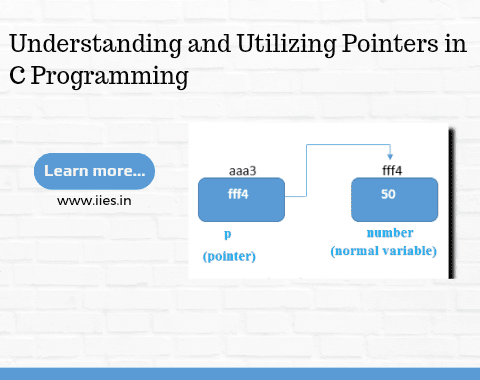
Pointers play a crucial role in C programming by allowing developers to manipulate memory and optimize their code. By understanding how pointers work, programmers can enhance their efficiency and flexibility when working with data. In this blog, we will explore the fundamentals of pointers in C and discuss their various applications.
Understanding and utilizing pointers in C is essential for efficient memory management and optimizing program performance. Pointers can be used to create and manipulate complex data structures like linked lists and trees. They also enable advanced techniques like function pointers and pointer arithmetic.
A pointer is a variable that maintains a record of another variable’s memory address. It allows us to indirectly access and manipulate the value of the variable it points to. Pointers are particularly relevant in C programming because they facilitate memory management. By using pointers, developers can dynamically allocate and deallocate memory on the fly, making their programs more efficient.
To dive deeper into pointer functionality, let’s explore how pointers work in C programming. Pointers, like any other variable, need to be declared before they are used. They are declared by specifying the data type they will be pointing to, followed by an asterisk (*) and the name of the pointer variable. For example, to declare an integer pointer named ptr, you would write int *ptr;.
Once a pointer is declared, it can be assigned the memory address of another variable using the ampersand (&) operator. This is also known as “taking the address” of a variable. For example, to assign the memory address of an integer variable num to the pointer ptr, you would write ptr = #. In this case, ptr now “pointers” to num.
We implement the indirection operator, commonly referred to as the dereference operator, to obtain access to the value of the variable that a pointer points to. This operator is denoted by the asterisk (*). For example, to access the value num using the pointer ptr, we would write *ptr. This retrieves the value kept at the memory location that ptr is pointing to.
Now that we understand the basics of pointers in C, let’s learn how to use them effectively. First, we need to declare and initialize the pointer variable. As mentioned earlier, this involves specifying the data type the pointer will be pointing to and assigning it a memory address.
Next, we can perform operations on the variable through the pointer. For example, if we want to update the value of num through ptr, we can write *ptr = 5;. This will update the value of num to 5.
Pointers also come in handy when working with arrays. Instead of passing the entire array to a function, we can pass a pointer to the first element of the array. This can save memory and improve performance, especially when dealing with large arrays.
In C, there are different types of pointers that serve various purposes. Some common types include:
Each type of pointer has its own significance and use cases. Understanding their differences and when to use them is essential for efficient programming.
Working with pointers can be challenging, and it’s common for programmers to make mistakes. Some common errors include:
To avoid these mistakes, it’s important for developers to understand the principles and best practices associated with pointer usage. Proper memory management and thorough testing are also critical to prevent errors.
Pointers offer several advantages in C programming, including:
By leveraging the advantages of pointers, programmers can optimize their code and create more efficient programs.
Pointers in C offer various features and functionalities that contribute to their versatility and data manipulation capabilities. Some notable features include:
These features make pointers a powerful tool in C programming, giving developers greater control over memory and data manipulation.
Passing pointers to functions can be a valuable technique in C programming. By passing a pointer to a function, we can modify the original variable directly, rather than working with a copy.
To pass a pointer to a function, we need to declare the function parameter as a pointer of the appropriate type. For example, if we want to modify an integer variable num using a function, we can declare the function as void update(int *ptr).
Within the function, we can then update the value of num by dereferencing the pointer and assigning a new value. For example, *ptr = 10; will update the value num to 10.
Passing pointers to functions can minimize memory usage and improve performance, especially when working with large data structures.
Pointers have broader implications in programming beyond their use in C. While they are fundamental to C programming, the concept of pointers extends to other programming languages as well. Understanding how pointers work in C can provide a solid foundation for programming in general.
Pointers contribute to efficient memory utilization, faster execution, and greater flexibility in data manipulation. By mastering the concept and application of pointers, developers can effectively optimize their code, leading to more efficient and robust programs.
In conclusion, pointers are a fundamental concept in C programming that allows developers to manipulate memory and optimize their code. By understanding how pointers work, programmers can leverage their features and advantages to create efficient and flexible programs.
Throughout this blog, we explored the definition and functionality of pointers, discussed their various types and associated use cases, and highlighted common mistakes to avoid. We also discussed the advantages of pointers and their significance in programming beyond C.
By applying the knowledge gained from this blog, programmers can harness the power of pointers to enhance their coding skills and create efficient, memory-optimized programs.
Must Read: A Step-by-Step Guide to Implementing a Stack in C Programming
Indian Institute of Embedded Systems – IIES